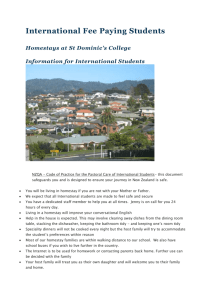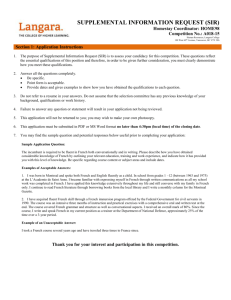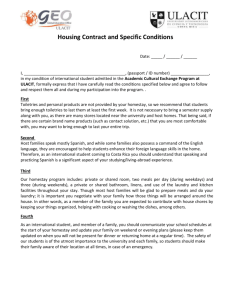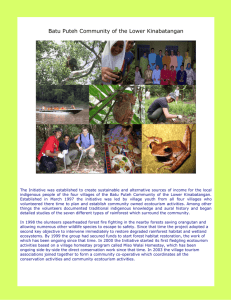Following the Trail of Women Homestay Entrepreneurs in Malaysia
advertisement
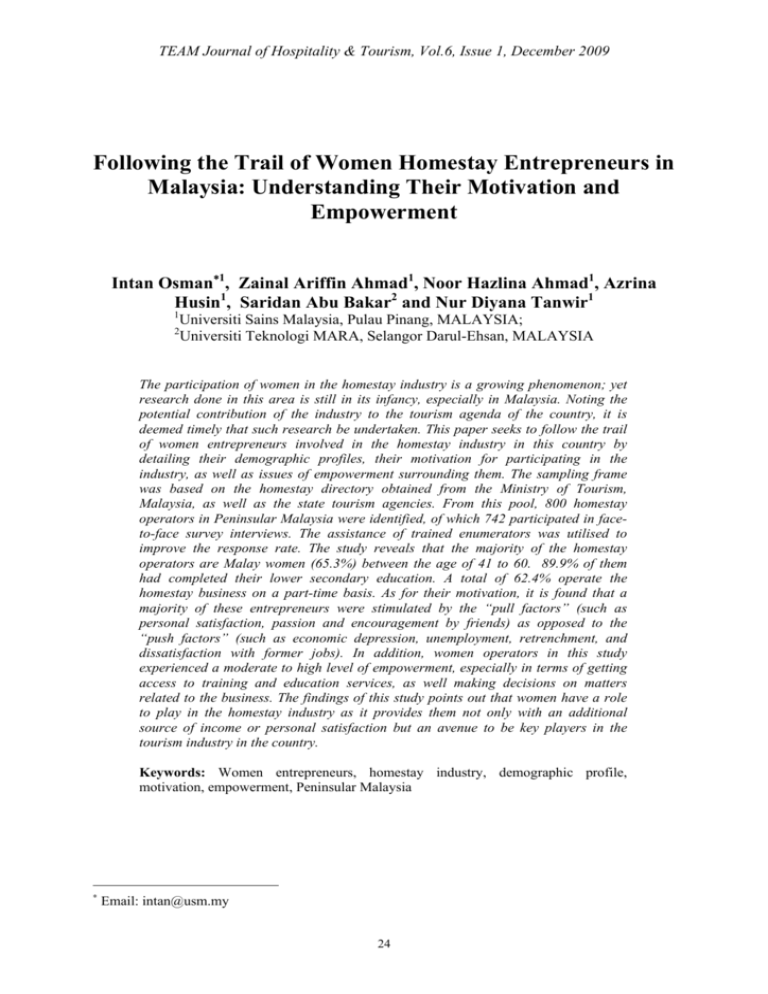
TEAM Journal of Hospitality & Tourism, Vol.6, Issue 1, December 2009 Following the Trail of Women Homestay Entrepreneurs in Malaysia: Understanding Their Motivation and Empowerment Intan Osman∗1, Zainal Ariffin Ahmad1, Noor Hazlina Ahmad1, Azrina Husin1, Saridan Abu Bakar2 and Nur Diyana Tanwir1 1 Universiti Sains Malaysia, Pulau Pinang, MALAYSIA; Universiti Teknologi MARA, Selangor Darul-Ehsan, MALAYSIA 2 The participation of women in the homestay industry is a growing phenomenon; yet research done in this area is still in its infancy, especially in Malaysia. Noting the potential contribution of the industry to the tourism agenda of the country, it is deemed timely that such research be undertaken. This paper seeks to follow the trail of women entrepreneurs involved in the homestay industry in this country by detailing their demographic profiles, their motivation for participating in the industry, as well as issues of empowerment surrounding them. The sampling frame was based on the homestay directory obtained from the Ministry of Tourism, Malaysia, as well as the state tourism agencies. From this pool, 800 homestay operators in Peninsular Malaysia were identified, of which 742 participated in faceto-face survey interviews. The assistance of trained enumerators was utilised to improve the response rate. The study reveals that the majority of the homestay operators are Malay women (65.3%) between the age of 41 to 60. 89.9% of them had completed their lower secondary education. A total of 62.4% operate the homestay business on a part-time basis. As for their motivation, it is found that a majority of these entrepreneurs were stimulated by the “pull factors” (such as personal satisfaction, passion and encouragement by friends) as opposed to the “push factors” (such as economic depression, unemployment, retrenchment, and dissatisfaction with former jobs). In addition, women operators in this study experienced a moderate to high level of empowerment, especially in terms of getting access to training and education services, as well making decisions on matters related to the business. The findings of this study points out that women have a role to play in the homestay industry as it provides them not only with an additional source of income or personal satisfaction but an avenue to be key players in the tourism industry in the country. Keywords: Women entrepreneurs, homestay industry, demographic profile, motivation, empowerment, Peninsular Malaysia ∗ Email: intan@usm.my 24 TEAM Journal of Hospitality & Tourism, Vol.6, Issue 1, December 2009 Introduction Tourism has been identified as one of the most vibrant industries worldwide. As a subindustry within tourism, the potential of ecotourism has been recognised to grow even further. Realising this, many countries seek to further develop this untapped industry. In Malaysia, services and products with ecotourism characteristics have the possibility to grow and sustain and, at the same time, contribute further to our tourism industry. As highlighted in the Ninth Malaysia Plan (2006-2010), a growth in tourism is seen to have a positive relationship to the expansion of other sub-sectors, especially the homestay industy as well as other ecotourism-related products and services. The Malaysian government views the homestay industry as an industry that has unique Malaysian appeal and thus proactively supports the growth of this sector. Homestay industry is usually packaged with local traditions and cultural appeal as well as natural heritage. This, in return, provides visitors with a distinct opportunity to experience the rich and hospitable local culture. On the other hand, homestay industry is also recognised by the government as an industry that will increase the participation of rural population in tourism-related activities. For this reason, rural households are encouraged to seize these opportunities to supplement and generate their household incomes as well as to be an important part of a budding industry. The number of homestay households has increased during the Ninth Malaysia Plan (2006-2010) with an increase of 463 trained and licensed homestay operators, bringing the total number to 2,808 from 142 villages nationwide. Despite the surge in numbers indicated above, research on the homestay industry is still in its infancy, particularly that focusing on the participation of women. Noting the potential contribution of the homestay industry not only to the tourism agenda of the country but also in the development of the community concerned, it is deemed timely that research of such kind be undertaken, especially pertaining to women. This is in line with Norman and McDonald’s (2004) call for women entrepreneurs to contribute to the sustainability of the homestay business which offers a multiplier effect on the country’s economic, environmental and social aspects. This paper seeks to follow the trail of women entrepreneurs involved in the homestay industry in this country by detailing their demographic profiles, their motivation for participating in the industry, as well as issues of empowerment surrounding them. Homestay in Malaysia The Homestay Program in Malaysia was introduced by the Ministry of Tourism in 1988 as an effort to diversify tourism products through the provision of an alternative accommodation for tourists. It was officially launched in 1995 at several locations by the Minister of Tourism. Different from hotel accommodation, the homestay enables tourists to stay with a chosen host family and experience the day to day activities of the host family, participate in traditional games, arts and crafts, as well as visit cottage industries such as batik factories. Homestay is perhaps one of the best ways for tourists to experience the Malaysian lifestyle and traditions. As such, it is highly tied to the ecotourism industry. In fact, the National Eco-Tourism Plan suggests that small village entrepreneurs can be involved in the ecotourism industry by managing homestays. In Malaysia, the homestay is an ecotourism package, as well as an agro-tourism, nature-tourism and cultural-tourism package, depending on the type of homestay the village offers. To promote the homestay program, in 2008 the then Tourism Minister Datuk Seri Azalina Othman Said launched the website www.homestay.motour.gov.my which listed homestay operators in Malaysia, together with their contact details, for tourists to make arrangements. It was also emphasised that the website would help the ministry monitor 25 TEAM Journal of Hospitality & Tourism, Vol.6, Issue 1, December 2009 homestay operators in order to keep the industry viable. The said registry of homestay operators also ensure proper budget distribution for homestay operations and management. As of September 2008, there were 2,808 homestay operators from 142 villages nationwide (New Straits Times, 25 September 2008) with each state in Malaysia featuring its own unique homestay program. Besides the Ministry of Tourism, there are other organisations including the State Tourism Action Board (Majlis Tindakan Pelancongan Negeri), State Homestay Co-coordinator (Penyelaras Homestay Negeri), and State Homestay Management Committee (Jawatankuasa Pengurusan Homestay Negeri) which are responsible for promoting and managing the homestay programs in their respective states. Homestay program arrivals recorded an increase from 38,965 in 2006 to 72,423 in 2007. Between January and June in 2008, there were 27,763 homestay tourists in Malaysia with the highest number of arrivals for homestay programs in Negeri Sembilan, Selangor, Johor, Sabah and Sarawak. Given the scenario discussed above, it is vital and timely to study women’s contribution to this promising industry, especially the factors that influence them to sustain the homestay operation, which in turn affects the growth of tourism sector in the country. The homestay program is also a strategy of the government to improve the living standard of the rural community, especially that of women. Our study hopes to highlight entrepreneurial factors amongst women, as well as the women’s demographic profiles that affect their participation in the homestay industry. Literature Review Literature on entrepreneurship has acknowledged the importance of motivation as one of the key factors in starting a business. Motivation includes psychological traits. Entrepreneurs are said to be individuals who possess personal characteristics such as the desire to seek achievements, ability to take risk, possession of certain leadership styles; they have also undergone a process of socialisation related to business (Brockhaus and Horowitz 1986). However, the degree to which these traits motivate entrepreneurs may vary from one society to another, as shown in studies on women entrepreneurs in Singapore (Lee 1996) and Nigeria (Woldie and Adersua 2004). On the other hand, motivation also refers to “opportunity structure, an ‘objective’ structure of economic opportunity and a structure of differential advantage in the capacity of the system’s participants to perceive and act upon such opportunities” (Glade, 1967:251 as cited in Thornton, 2009). This in turn points to the social context that turns one into an entrepreneur, such as the influence and roles of markets and firms on the individuals who become entrepreneurs (Thornton 2009), as well as displacement from previous jobs (Shapero and Sokol 1982). Homestay is a home-based industry in which family relations as well as gender issues come to play. Loscocco and Smith-Hunter (2004) show that women who own home-based businesses face less family conflict than those who run their businesses outside the home, and because their primary priority remains their family and their roles within the family, the former may enjoy less success than their female counterparts. A study conducted on family businesses in rural China shows that men tend to run these businesses as opposed to women, thus disproving the notion that women will be at a better position to take advantage of their gender roles within the family (Entwisle et al 1995). Homestay industry can be seen as a “community-based ecotourism venture”, a term propagated by scholars to accentuate the benefits gained by the local community whose life, to varying degrees, is touched by tourism activities (Ceballos-Lascurain 1996). This developmental approach to tourism should be able to empower the local community at four levels: psychological, social, political and economic (Scheyvens 1999). Economic gains and 26 TEAM Journal of Hospitality & Tourism, Vol.6, Issue 1, December 2009 independence have been shown to bring about greater empowerment for women. Valaoras, Pistola and Pistola (1999), for example, showed that women participation in ecotourism in Greece had opened up alternative doors for income generation, and had created awareness on issues pertaining to environment conservation. On the same note, Pleno (2006) demonstrated how ecotourism projects increased the level of participation, mobilisation and socialisation among women. A local study conducted by Jamaliah Jamil and Amran Hamzah (2007), on the role played by a women’s association in supporting women entrepreneurs participating in the homestay program in the state of Selangor, showed that the group served as a platform to bring together women involved in the homestay industry by giving them further opportunities to earn extra income and be part of the homestay community in the area. The association also empowers these women by equipping them with skills needed in the homestay industry, via training. Method The present study is part of a larger study, “Women’s Participation in Sustainable Development: SME’s Entrepreneurship in Ecotourism for Value Creation Services”, a Universiti Sains’ Research Universiti Grant, bearing an Account No: 1001/PMGT/816051, that attempts to examine the participation of women homestay operators, as well as the factors affecting their participation in the sustainable development of this industry. Personal and external factors are taken into account. Noting that the study of women participation in homestay industry is still at its infancy stage, this study intends to trace the path of these entrepreneurs by investigating their demographic profile, their motivation to participate in this industry as well as the empowerment issue deemed relevant to these women entrepreneurs. Sample The sampling frame was based on the homestay directory obtained from the Ministry of Tourism, Malaysia (http://www.homestay.matour.gov.my). As of July 2008, there are 137 villages with 106 registered homestays comprising 2808 homestay houses. Calls were also made to the state tourism agencies to identify homestay operators not listed in the directory. Altogether, a total of 800 operators were identified of which 742 participated in this study, yielding a high response rate of 92.7%. Given that enumerators were employed to conduct face-to-face interview surveys at each location, this high response rate was expected. Approximately 62% of the respondents reported that they engaged in homestay industry on a part-time basis, a reflection on the fact that the penchant to participate in the industry was more towards “life-style” entrepreneurship. 27 TEAM Journal of Hospitality & Tourism, Vol.6, Issue 1, December 2009 Table 1 Homestay List by State in Malaysia Location of Homestay by State Selangor Pulau Pinang Number of Registered Homestays 17 9 Number of Respondents 150 148 Pahang Terengganu 22 6 113 53 Johor Kelantan 15 7 44 43 Melaka Kedah 4 6 39 36 Perak 6 33 Perlis Langkawi Negeri Sembilan 2 4 8 28 23 23 106 742 TOTAL Survey Instrument Items reflecting “motivation” (i.e., pull and push factors) were adapted from Ahmad (2007); they comprise 20 items, out of which 13 reflects the pull factors. The remaining 7 items reflect the push factors. A 5-point Likert scale was used, allowing ratings from 1 (very low) to 5 (very high). On the other hand, “empowerment” was measured using 8 items adapted from Kabeer (2001). Participants rated each item in terms of the extent to which they agree to the statements reflecting empowerment issues such as “allow to make decision on matters related to homestay”, “tend to have control over decision making on matters related to homestay”, “involved in decision making process at community level on matters related to homestay”, and “my voice seems to matter in decision making process at community level on matters related to homestay”. Similarly, a 5-point Likert scale was used, allowing ratings from 1 (strongly disagree) to 5 (strongly agree). Data collection procedure Twenty-four enumerators, which consist of Bachelors of Management and Social Sciences students from Universiti Sains Malaysia (USM), Universiti Technology MARA (UITM) and Universiti Technologi Malaysia (UTM), were trained to collect data from the identified respondents. Each enumerator was provided with several sets of questionnaires and was instructed to collect data at the selected locations within Peninsular Malaysia. Prior to data collection, calls were made to each site informing them about the visit. Enumerators were given a month to complete the data collection. 28 TEAM Journal of Hospitality & Tourism, Vol.6, Issue 1, December 2009 Result and Findings Demographic Profile of Homestay Operators As shown in Table 2, the majority of the respondents are women (65.3%) with men comprising 34.7% of the total sample, reflecting the prominent role women have in the homestay industry. The majority of the respondents are in the age group of 41 to 60 years old (65.9%). 88.1% of the respondents are married. Almost all of them are Malay (99.7%), reflecting the high composition of this cohort in the homestay industry. 89.9% of the respondents have primary to lower secondary level of education. Table 2 Profile of Respondents (N=742) Gender Male Female Age Less than 30 31-40 41-50 51-60 Above 60 Race Malay Chinese Indian Education Level Degree and above Diploma Certificate Lower Secondary Upper Secondary Primary Others 29 Frequency % 256 481 34.7 65.3 14 71 219 267 166 1.9 9.6 29.7 36.2 22.5 740 1 1 99.7 0.1 0.1 14 14 25 186 171 298 21 1.9 1.9 3.4 25.5 23.5 40.9 2.9 TEAM Journal of Hospitality & Tourism, Vol.6, Issue 1, December 2009 Table 2 Profile of Respondents (N=742) (Contd.) Marital Status Single Married Divorce Widow Registered as homestay owners Yes No Mode of Participation Full time Part time Engaged in other job Yes No Previous Occupation Self-employed Employed Home-maker Years in homestay 1-3 4-6 7-9 10 and above Involvement in homestay committee Yes No Child Assistance in Homestay Yes No Frequency % 17 643 10 60 2.3 88.1 1.4 8.2 545 191 74 26 279 463 37.6 62.4 486 245 66.5 33.5 180 159 109 40.2 35.5 24.3 299 206 91 99 43 29.6 13.1 14.2 230 508 31.2 68.8 389 345 53 47 Motivation of the Homestay Operators At the outset of the study, it was highlighted that studies which attempt to investigate the participation of women homestay operators are rather limited. Thus, the motivating factors stimulating women to participate in the homestay industry need to be delved into. As depicted in Table 3, it is evident that the homestay operators were motivated by the “pull factors”. The most important reasons for engaging in homestay industry are personal satisfaction (M=4.14) followed closely by passion in the business (M=4.12), and encouragement from friends (M=4.03). Having said that, other “pull factors” such as to generate more income, to prove own ability to be successful, to seize available opportunity as well as to have control over one’s own action are also significant motives for their involvement in the industry. Interestingly, the “push factors” which include economic depression, unemployment, retrenchment, dissatisfaction with former job, no job security in the previous employment, frustrated with the level of income in the former job and work pressure due to downsizing, 30 TEAM Journal of Hospitality & Tourism, Vol.6, Issue 1, December 2009 were rated very low in terms of the reasons to engage in homestay business. This finding suggests that they are not being “pushed” to the industry by these external forces. Rather, the prime motivations are their passion and inclination to pursue something they enjoy doing and this is probably further reflected in the high number of those who engage in this business on a part-time basis. Table 3 Motivation of Women Homestay Operators (N=481) Items Mean SD 1. 2. Pull factors Desire to generate more income Passion in this business 3.81 4.14 1.17 1.02 3. 4. To prove own ability to be successful Personal satisfaction 3.35 4.07 1.40 1.06 5. 6. 7. 8. 9. 10. 11. 12. 13. Pursue one’s own interest Desire to own a business Desire to have control over what one is doing Desire for more flexibility in managing own time See the opportunity/potential in this business Inspired by friends’ and other peoples’ success Encouraged by a friend Desire for a balanced lifestyle Desire for a balance between work and family 3.90 2.92 3.17 3.20 3.37 3.56 3.61 2.94 2.84 1.35 1.56 1.50 1.45 1.48 1.63 1.60 1.60 1.65 0.70 0.33 0.16 0.23 0.22 0.23 0.17 1.34 0.94 0.61 0.77 0.73 0.75 0.63 14. 15. 16. 17. 18. 19. 20. Push factors Economic Depression Unemployed Retrenched Dissatisfaction with former job No job security in the previous employment Frustrated with the level of income in the former job Work pressure due to downsizing Empowerment of Homestay Operators Empowerment enables women to have a sense of pride and awareness of the importance of their control over their own development (Wearing and Larsen 1996). As depicted in Table 4, most of the homestay operators in this study rated the sense of empowerment to be above 3.00, indicating that they experience a moderate to high level of empowerment, especially in terms of access to training and education services (M=4.09), the ability to make decision on matters related to homestay business (M=3.72), the ability to have control over decision making on matters related to homestay (M=3.53), as well as the ability to access resources and information required for homestay activities. 31 TEAM Journal of Hospitality & Tourism, Vol.6, Issue 1, December 2009 Based on the findings, it can be inferred that managing a homestay business offers a sense of psychological empowerment that could boost one’s self-esteem, allowing women operators to expand their horizon and break the status quo from being traditionally passive to active players in the community, especially in terms of having control over decision making and exposure to education and training. Table 4 Empowerment of Women Homestay Operators (N=481) Items 1. I am allowed to make decision on matters related to homestay. Mean SD 3.72 1.25 2. I tend to have control over decision making on matters related to homestay. 3.53 1.31 3. I normally get involved in decision making process at community level on matters related to homestay. 2.98 1.55 4. My voice seems to matter in decision making process at community level on matters related to homestay. 3.06 1.49 5. I tend to have access to training or education services. 4.09 1.20 6. I tend to have access to resources and information required for homestay. 3.32 1.32 3.26 1.78 3.28 1.79 7. I normally need permission from the head of the household to decide on matters related to homestay. 8. I normally consult head of the household on matters related to homestay. Discussion The majority of the respondents are women (65.3%) signifying the importance and significant contribution of women in the homestay industry in Malaysia. Most of the respondents are married (88.1%). They operate homestay on a part-time basis (62.4%) while only about one-third of them (37.6%) reported that they are full-time homestay operators at the time of the research. Thus, the majority of the homestay operators regard their involvement in this business as a means to generate extra household income and not as the primary income source. Another interesting finding of this study is that nearly half the respondents (43%) have operated their homestay business for a period of 1 to 3 years, suggesting that they are rather new in this business eventhough the homestay program was officially introduced in 1988. Despite their low educational qualification and operating homestay independently (47%), these homestay operators were highly empowered to gain access to training or education services and make decisions on matters pertaining to homestay operations. As these training and skills will help them to continually enhance the quality of their homestay services, this finding suggests that they are aware of this fact and seek ways to improve themselves in order to sustain their business, despite running it on a part-time basis. 32 TEAM Journal of Hospitality & Tourism, Vol.6, Issue 1, December 2009 The majority of the respondents are between 41 to 60 years of age (65.9%) indicating that they still have the energy and passion to pursue an interest in operating a homestay business and at the same time gain personal satisfaction from the operation. Clearly, the social factor also contributed to the push factors, as operators started their homestay operations after receiving inspiration and encouragement from friends who are themselves already successful in the homestay operation. This also reflects the close-knit nature of the Malay culture that emphasises community support and cooperation. Homestay activitives for the guests are normally organised as community-based activities. As for the “push factors”, the study shows that external factors such as being retrenched, work pressure due to downsizing and no job security in the previous employment were not the reasons for the respondents to operate a homestay. Conclusion In conclusion, this study provides some understanding of homestay operators in the Malaysian context. It was found that women as homestay operators have a significant link to motivational pull factors as well as empowerment. The study showed that women homestay operators are highly motivated by personal satisfaction, passion in the business, and received encouragement from friends to operate their homestay. In addition, women homestay operators were highly empowered to make decisions and gain access to training or education services pertaining to homestay operations. Therefore, this study offers an avenue to better understand women’s involvement in homestay as well as the motives to engage in the homestay industry. 33 TEAM Journal of Hospitality & Tourism, Vol.6, Issue 1, December 2009 References Abdullah, J. L. 2006. Ecotourism Opportunities in the Asia Pacific Region: Malaysia. 4th Asia Pacific Ecotourism Conference (APECO), Taman Negara Park Malaysia. From http://www.geocities.com/discoverytravelchannel1/APECO2006 /APECO2006JunaidaLee.htm Ahmad, N. 2007. A Cross-cultural study of entrepreneurial competencies and entrepreneurial success in SMEs in Australia and Malaysia. Unpublished doctoral thesis, University of Adelaide. Akama, J. 1996. Western environmental values and nature-based tourism in Kenya. Tourism Management 17 (8): 567-574. Akpinar, N. et. al. 2005. Rural Women and Agrotourism in the Context of Sustainable Rural Development: A Case Study From Turkey. Environment, Development and Sustainability, Vol. 6. Anonymous. Sep 25, 2008. Homestay programme goes online; New Straits Times. Kuala Lumpur. From http://proquest.umi.com/pqdweb/?did= 1560839861andsid=5andFmt=3andclientId=27905andRQT=309andVName=PQD p.18. Baum, J. R., Locke, E. A., and Smith, K. G. 2001. A Multidimensional Model of Venture Growth. Academy of Management Journal, 44(2): 292-303. Brockhaus, R.H. and Horowitz, P.S. 1986. The psychology of the entrepreneur. In The Art and Science of Entrepreneurship, eds. D.L. Sexton and R.W. Smilor, p. 25-48. Ballinger: Cambridge, MA. Ceballos-Lascurain, H. 1996. Tourism, Ecotourism and Protected Areas. Gland, Switzerland:IUCN (World Conservation Union). Colbert, B. A., and Kurucz, E. C. 2008. Three Conceptions of Triple Bottom Line: Business Sustainability and the Role for HRM. From www.wolfinstitute.com. Dilly, B. J. 2003. Gender, Culture, and Ecotourism: Development Policies and Practices in the Guyanese Rain Forest. Women's Studies Quarterly, Fall (31): 58. ESCAP (United Nations Economic and Social Commission For Asia and the Pacific). 2003. ‘Report on Seminar on Poverty Alleviation Through Sustainable Tourism Development’, paper presented, August 26-28. Intan Osman, Zainal Ariffin Ahmad, Noor Hazlina Ahmad, Sabai Khin and Azrina Husin. 2008. Participation of Women Entrepreneurs in Ecotourism Industry: A Proposed Model. In RARC International Conference 2008. Knowledge Infrastructure Management from Tourism Penang Malaysia 3-4 November 2008. RIKKYO Amusement Research Centre. Tourism Project Series No. 02. p. 212-223. Jamaliah Jamil and Amran Hamzah. 2007. “Rural Tourism Research: The KPW and Women Roles in Banghuris Homestay” from http://elib.unitar.edu.my/staffpublications/Jamiliah/rural-tourism.pdf . Johnson, B. and Turner, L. A. 2003. Data collection strategies in mixed-methods research. In Handbook of Mixed Methods in Social and Behavioral Research, eds. Abbas Tashakkori and Charles Teddlie, p. 297-320. Newbury Park: Sage Publication. Kabeer, N. 2001. Reflections on the Measurement of Women’s Empowerment. In Discussing Women’s Empowerment-Theory and Practice, Ida Studies No. 3. Novum Grafiska AB: Stockholm. Kantor, P. 2005. Determinants of women's microenterprise success in Ahmedabad, India: Empowerment and economics. Feminist Economics, 11(3): 63 - 83. Lee, J. 1996. The motivation of women entrepreneurs in Singapore in Women in Management Review, 11 (2) : 18-29. 34 TEAM Journal of Hospitality & Tourism, Vol.6, Issue 1, December 2009 Loscocco, K. and Smith-Hunter, A. 2004. Women home-based business owners: insights from comparative analysis. Women in Management Review,19 (3): 164-173. McCracken G. 1988. The Long Interview. London: Sage Publications. Ministry of Tourism. 2008. From http://www.homestay.uum.edu.my/ Morse, J. M., and Richards, L. 2002. Readme first for a user's guide to qualitative methods. California, USA: Sage Publications. Ninth Malaysia Plan 2006-2010, Economic Planning Unit, Prime Minister’s Department, Putrajaya, 2006. Patton, M. Q. 1990. Qualitative Evaluation and Research Methods. Newbury Park: Sage Publications. Pleno, M. J. 2006. Ecotourism Project and Women Empowerment: A case study in the province of Bohol, Philippines. Forum of international Development Studies. Rani, B. S., and Rao, D. K. 2007. Perspectives on Women Entrepreneurship. The Icfai University Press. Redmond, C. A. 2001. Endangering Ecotourism: Analysis of Women Participation in Ecotourism in Belize. Applied Research Project Report in Partial Fulfillment of the requirements for the Masters of Arts Degree in International Development Studies: Saint Mary's University Canada. Sangpikul, A. 2007. A Review of Ecotourism Studies in Thailand. Conference Proceeding: 5th Tourism Educators Conference on Tourism and Hospitality. Scace, R. 1993. An ecotourism perspective. In Tourism and Sustainable Development: Monitoring, Planning, Managing, eds. J. Nelson, R. Butler and G. Wall, p. 59-82. Waterloo: Heritage Resource Centre: University of Waterloo. Scheyvens, R. 1999. Ecotourism and the empowerment of local communities. Tourism Management, 20 (2): 245-249. Shapero, A. and Sokol, L. 1982. The social dimensions of entrepreneurship. In Encyclopedia of Entrepreneurship, eds. C.A. Kent, D.L. Sexton and K.H. Vesper, p.72-90. Englewood Cliffs, NJ: Prentice–Hall. Shaw, E. 1999. A guide to the qualitative research process. Qualitative Market Research: An International Journal, 2(2): 59-70. Valaoras, G., Pistola, N. A., and Pistola A. K. 1999. The role of women in the conservation and development of the Dadia Forest Reserve. Dadia Women’s Cooperative, from http://www.mtnforum.org/oldocs/428.pdf. Wearing, S., and Larsen, L. 1996. Assessing and managing the socio-cultural impacts of ecotourism: Revisiting the Santa Elena Rainforest Project. The Environmentalist 16: 117-133. Woldie, A. and Adersua, A. 2004. Female entrepreneurs in transitional economy: Businesswomen in Nigeria, International Journal of Social Economics 31 (1/2): 7893. Women Business Council (WBC) of Brunei, from http://bruneiwbc.com/wbc news_extract.php? 35
